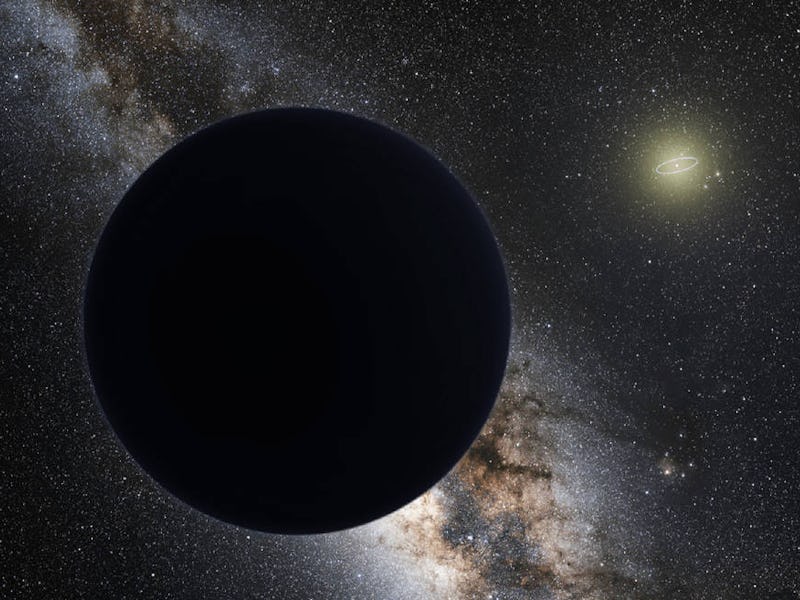Scientists discover a super-rare 'super-Earth'
The planet was detected through its light bending effect on a distant star.

Although the cosmos extends across billions of galaxies, each containing millions of stars and even more possible worlds orbiting those stars, a planet like our own is still proving to be quite rare.
In the hunt for planets orbiting stars that aren't our own Sun, scientists have only been able to find a handful of exoplanets that resemble Earth. And each discovery inches us a little closer to finding habitability outside our Solar System.
A team of astronomers recently discovered a new 'super-Earth,' or an exoplanet that bears some similarity to our own planet.
The finding was published this week in The Astronomical Journal.
The newly discovered exoplanet is located near the center of the galaxy, and is about four times the mass of the Earth. It orbits a dim dwarf star that's about 10% the mass of the Sun at a distance that falls somewhere between the orbital distance of Earth and Venus.
The exoplanet would likely orbit around its host star in around 617 days due to the star's low mass.
The latest discovery is a new addition to only a handful of exoplanets with a similar size and orbit to Earth.
What is a super-Earth? Although they are rare, super-Earths are quite exciting. A super-Earth is an exoplanet that is similar to the size of Earth, although usually more massive. The exoplanets' mass tends to fall between that of Earth, and Solar System giants such as Uranus and Neptune.
A side-by-side comparison of Earth and a super-Earth.
Its size is a good indication of its habitability since the exoplanet would not be too big where it would be surrounded by an envelope of gas, and that it would most likely be a rocky planet like the Earth (as opposed to a gas giant like Jupiter, for example).
However, there are many more factors to consider, such as whether or not the planet orbits within its star's habitable zone, or a far enough distance to be able to host water on its surface, and if its atmosphere has the proper chemical composition to support life.
Super-Earths have mainly been discovered orbiting a brown dwarf star, which makes it harder to detect them since their transit signals would be too weak. A transit signal is the main way of finding exoplanets orbiting around distant stars by detecting the dip in the light of a star that is most likely due to a planet transiting in front of a telescope's view of the star.
However, in order to find this newly discovered super-Earth, the team of astronomers turned to a different method known as gravitational microlensing.
Gravitational microlensing is based on the fact that the gravitational tug of large objects in the universe warp light coming from a different object. In the case of this exoplanet, the gravity of both the planet and its host star acted on the light of a distant background star, causing it to be magnified, according to the researchers.
This gravitational effect is quite rare to witness since it only affects about one in a million stars at any given time.
“To have an idea of the rarity of the detection, the time it took to observe the magnification due to the host star was approximately five days, while the planet was detected only during a small five-hour distortion," Antonio Herrera Martin, a researcher at the University of Canterbury, and lead author of the new study, said in a statement. After confirming this was indeed caused by another ‘body’ different from the star, and not an instrumental error, we proceeded to obtain the characteristics of the star-planet system,” he says.
The team of researchers behind the discovery used observations from three identical telescopes in Chile, Australia, and South Africa.
Abstract: We report the analysis of the microlensing event OGLE-2018-BLG-0677. A small feature in the light curve of the event leads to the discovery that the lens is a star–planet system. Although there are two degenerate solutions that could not be distinguished for this event, both lead to a similar planet-host mass ratio. We perform a Bayesian analysis based on a Galactic model to obtain the properties of the system and find that the planet corresponds to a super-Earth/sub-Neptune with a mass of . The host star has a mass of . The projected separation for the inner and outer solutions are au and au respectively. At , this is by far the lowest Δχ2 for any securely detected microlensing planet to date, a feature that is closely connected to the fact that it is detected primarily via a "dip" rather than a "bump."